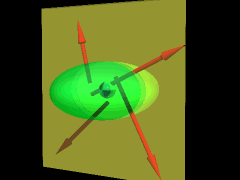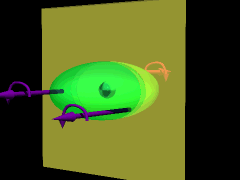| Ch 5. Rigid Body Equilibrium | Multimedia Engineering Statics | ||||||
|
2-D and 3-D Supports |
Equilibrium in 2-D |
Equilibrium in 3-D |
Indeterminate Objects | 2 and 3 Force Members | |||
| Equilibrium in 2-D | Case Intro | Theory | Case Solution | Example |
| Chapter |
| 1. Basics |
| 2. Vectors |
| 3. Forces |
| 4. Moments |
| 5. Rigid Bodies |
| 6. Structures |
| 7. Centroids/Inertia |
| 8. Internal Loads |
| 9. Friction |
| 10. Work & Energy |
| Appendix |
| Basic Math |
| Units |
| Sections |
| Search |
| eBooks |
| Dynamics |
| Fluids |
| Math |
| Mechanics |
| Statics |
| Thermodynamics |
| Author(s): |
| Kurt Gramoll |
| ©Kurt Gramoll |
|
|
||
 Forces
|
For a rigid body in equilibrium, the sum of all the forces and the sum of all the moments must be zero, ΣF = 0 ΣM = 0 Using rectangular coordinates, these equations can be expressed by the vector equations, ΣF = ΣFxi + ΣFyj + ΣFzk = 0 ΣM = ΣMxi + ΣMyj + ΣMzk = 0 For the expanded equation, each coefficient of the i, j, and k unit vectors must equal zero for static equilibrium. ΣFx = 0 ΣFy = 0 ΣFz = 0 ΣMx = 0 ΣMy = 0 ΣMz = 0 The equilibrium equation has been separated into three components corresponding to the x, y, and z axes for both the forces and moments. Since each equation is independent of the others, the equations can be used to determine up to six unknowns for a full 3D problem. |
|
| Equilibrium Equations |
||
|
"Two-dimensional" is used to describe problems in which the forces reside in a particular plane (x-y for example), and the axes of all moments are perpendicular to the plane. Because there is no force in the z direction, and no moments about the x- or y-axis, three of the six independent scalar equations are automatically satisfied. The remaining equations for a rigid body in 2-D equilibrium are ΣFx = 0 ΣFy = 0 ΣMz = 0 Since there is a maximum of three independent equations for a rigid body in two-dimensional equilibrium, only three unknown forces or couples can be solved. |
||
Practice Homework and Test problems now available in the 'Eng Statics' mobile app
Includes over 500 free problems with complete detailed solutions.
Available at the Google Play Store and Apple App Store.
